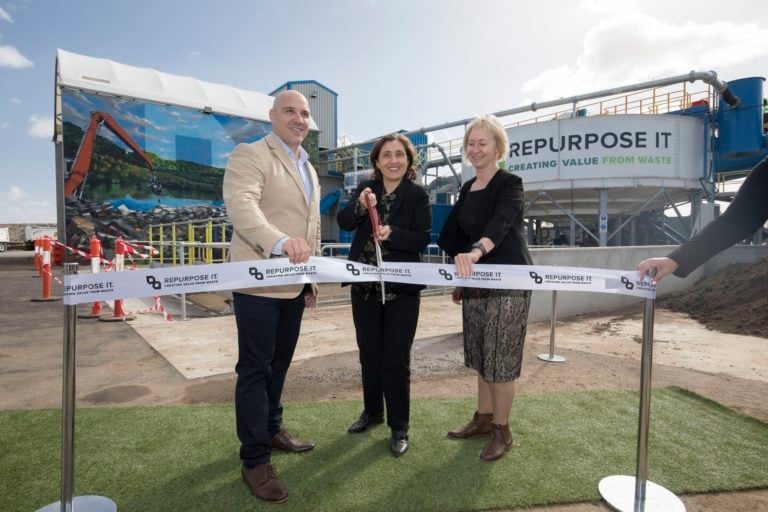When it comes to landfill waste, the construction and demolition industry is notoriously the biggest ‘player’, accounting for over a third of all waste that ends up there.
With 15 years of experience in civil construction, George Hatzimanolis knew this all too well when he decided to be part of a shift in his field.
“My passion for sustainability really grew seven to eight years ago, when I started research on substitutes for virgin materials I was utilising in my asphalt business … and from there I realised there was a whole different world of opportunity for resource out there, beyond traditional quarries,” he tells Neos Kosmos.
This is how the idea for Repurpose It started, the company he set up almost two years ago with fellow co-founders joining skill sets across infrastructure, road construction, green waste and even logistics.
Their vision was to contribute towards a future of circular economy – an economic system aimed at minimising waste and making the most of resources. And the end result? The transformation of a 150-acre clean fill in Melbourne’s Epping into a resource recovery park. The site hosts the company’s new state-of-the-art washing and recycling plant for construction and demolition (C&D) waste, which attracted a $500,000 grant through the state government’s Resource Recovery Infrastructure Fund.

Mr Hatzimanolis says the timing was ideal for the venture. With waste volumes predicted to grow by 63 per cent by 2042, according to recent government data, tackling these is a statewide priority.
“At the moment, in particular in Melbourne, there’s an infrastructure boom and our population is growing at unprecedented levels,” he says, explaining that this translates to great demand for quarries to supply infrastructure materials.
“On top of that, as we are renewing the infrastructure, we generate waste. There are a lot of materials that can be recovered. Our vision when setting up the business was about investing in technology that could recover those precious resources.”
READ MORE: OPINION Recycling crisis – state, national leadership and action urgently needed
WASTE TO VALUE
And so they did, bringing a unique know-how to Australia for the first time following visits to the world’s best practice regions in the industry, including Germany, the UK, Denmark and Sweden.
The challenge in treating C&D waste for recycling is dealing with contaminants they are commonly mixed with.
The team invested in wet processing technology that has been found effective in treating contaminated waste, rather than conventional dry screening.
“If you think about any infrastructure across road or rail, or even tunnelling projects, that type of excavation waste is predominantly the one we source and wash in our plant,” Mr Hatzimanolis says, adding that other waste streams it is used for include wasted glass.
Following the treatment and processing, waste is turned into raw materials for civil and infrastructure projects ending up for example in asphalt, concrete, rail ballast or glass manufacturing.
Quality-wise, the outputs are as good as virgin materials, he says, referencing their R&D work in this space, and accreditation received for their products from NATA (National Association of Testing Authorities) laboratories.

READ MORE: No more free plastic grocery bags in Greece
INDUSTRIAL ECOLOGY
Meanwhile, Repurpose It prides itself on working towards industrial ecology, in making landfills a thing of the past and launching a low-emissions facility compared to standard industry operations.
“An external environmental agency has done a life cycle assessment … looking at the difference between sending waste to landfill and the cost to quarry the resource from a virgin quarry versus sending that material to our facility, washing and recovering the aggregates,” he says.
“Our facility has the capacity to process 500,000 tonnes per annum. So in terms of CO2 savings, we can have an excess of 84,000 tonnes of CO2 every year, a number equivalent to planting 300,000 trees.”
The company has already partnered with Victorian Government projects, such as the level crossing removals, Metro Trains and North East Link, while there has also been interest from the private sector.
“The more we work with government agencies to promote the procurement of our materials, then the more sustainable this type of investment and technology becomes,” says Mr Hatzimanolis acknowledging that business innovation always involves risk.
But for him personally, the courage to try new things – an attribute he partially credits to his background – is part of his work ethic.
“My [paternal] family is from the island of Chios, my mother from Florina. I’m very proud of my Greek heritage,” he says.
“I think that Greeks in general, we’re very passionate, and for me being passionate means being humble but also not afraid to think bold, which I believe comes a lot from my heritage and has helped me in my professional career.”









